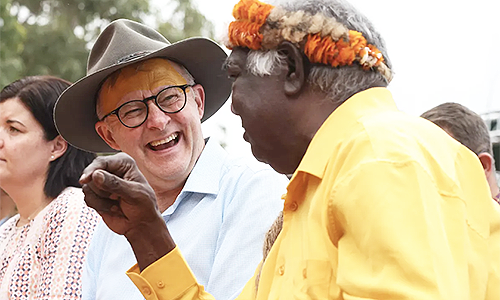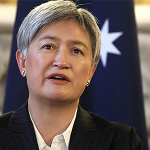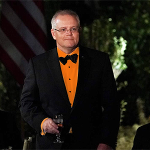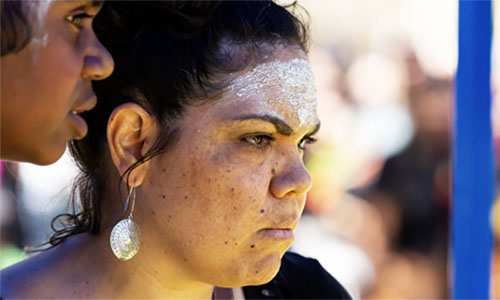
by ROGER CROOK – WHEN Prime Minister Albanese visited the NT last year, he never asked to be taken to the town camps to see the disfunction for himself; probably because he had to get back for the Australian Tennis Open.
Out of sight is out of mind in Australia. Politicians are pursuing their ideological objectives rather than meeting the needs of the people.
- All of Australia saw what was happening in Alice Springs.
- Is disfunction the right word or should it be neglect, abandonment or desertion?
- Successive governments thought lots of money would make the problem go away?
I am currently reading Poor Fellow my Country for the second time. I first read it in the nineties; have you read it?
It’s by Xavier Herbert; probably Australia’s best author. It’s about life in the north of Australia in the 30s, and the interactions between Aboriginal Australians and other Australians.
COMPLICATED
It’s a long and complicated story in some ways, but I understand, a true depiction of life in the Territory, out from Palmerston, Darwin way.
There were problems in those days with alcohol – “the grog” – among the Aboriginals. Herbert’s depiction of life in the far north is quite stark and gives us a clear picture what conditions were like in the Territory nearly a hundred years ago.
Over the past 50 years billions of dollars have been spent, ostensibly, to improve the standard of living of our Aboriginal Australians.
As a farm and station manager I have seen the work of many people, black and white, who have devoted their lives to that cause. Too often have I seen the disappointment in their eyes, the shrug of the shoulders and too often a tear driven by frustration.
As a consultant I did a few jobs for ATSIC; I describe a couple of them later. I rejoiced when ATSIC was disbanded, I had long stopped taking their money.
In 1967, some sixty years after the time depicted in Herbert’s novel, I had my first sight of Aboriginal people. I was travelling north from Perth in Western Australia.
A few kilometres south of a small county town, we passed a group of Aboriginal women and children walking on the gravel strip alongside the bitumen road, it was a hot day.
Some of the children were on the hip, some walking. Some had thongs, some didn’t. I had not expected to see this in Australia; it looked third world.
I asked who they were. The reply was that they were Aboriginals from the Reserve back down the road, together with the comment, “It might be pension day”.
When we got to the town, it was indeed pension day. There was a group of intoxicated people outside the pub, the majority were Aboriginal; there was every sign of a fight to come. We bought some bread from the bakery and headed north again.
A year later I had a new job as head stockman on a property adjacent another small country town in the WA wheatbelt.
The Native Reserve was on the boundary, with just the rail track between them and us. The Reserve was next to big grain bins.
DOGS
Dogs from the Reserve sometimes got into the paddock after the sheep, they damaged the wethers less than ewes and lambs. It was a fact that I never got the same number of sheep out of the paddock as I put in.
The magistrates court in town primarily had to deal with wayward Aboriginal men and women, mostly it was violence and the grog. Some went to jail and then came home, and some went away again only to come home again. That’s how it was.
The Aboriginal Reserve on our boundary was squalid; it always seemed to be overcrowded with people and dogs.
A few years later we went to the West Kimberly to run a cattle station for a while. Instead of taking care and feeding all and sundry out of the station store which had been the tradition, we paid the stockmen – and any women who worked – basic wages, less their keep, clothing, tobacco and that sort of thing. It was a dry station, no grog.
During the infrequent breaks in mustering, the wages we paid in cash to our Aboriginal staff was spent on grog. Swan brewery thrived.
The families who stayed in Broome and Derby drew pensions, the majority of which was spent on grog. There were hungry Aboriginal children in those days.
One of our stockmen, Bill, I will call him, had walked “out” of the Gibson Desert as a boy. He had been educated at the Mission and was a fine warrior of a man; Bill died one night, drunk. Apparently, he had been drunk for days.
An Aboriginal stockman, Peter, I will call him, was the same age as me. Peter had also been educated at the Mission; he could read and write, read a map, fix a vehicle, weld and ride a horse like it was part of him. When I met him, he was teetotal, and he was my friend; we spent many nights camped out while looking for cattle.
One night I hit Peter on the head with a lump of wood; somehow, he had got his hands on some grog. When I told him to go away and sober up, he became very violent, so I hit him.
The next day he was distressed and crying, he could not believe what he had done; he refused to go mustering. After a few days he was smiling again.
I heard a couple of years after I had left the Kimberley that Peter had died of the grog and some medical condition caused by the drink. I had not, so he hadn’t, reached forty years of age.
In the late 80s as consultants, a colleague and I drove out to a new Aboriginal community in the outback of WA. The closest regional town was five 500km away. Our consultancy was for ATSIC and the WA Government.
This small community of about thirty new houses had 240-volt power 24/7. A new bore had been drilled to provide abundant fresh water. The houses had three bedrooms and a living room kitchen; bottled gas was fitted to new gas stoves and were modestly furnished after they were built.
MALNUTRITION
A small citrus orchard had been planted for the community and was irrigated. There was a community office with satellite communications. I think the houses had satellite TVs.
There was a school with three teachers. I asked one of the young lady teachers what her biggest problem was at the school, and she replied, malnutrition.
“Children arrive with a can of Coke and a piece of bread or damper and after the sugar hit, they are asleep by 10am. They don’t come back in the afternoon.”
Our mission was to determine the viability of a general store for the community. The authorities – ATSIC et al – had gone to all the expense, millions probably, to establish a home for this particular “mob”, but hadn’t provided a store for food and other essential supplies.
There was a cattle station store 50km away and it was common for the Aboriginal people from the community to “book up” at the station in between their trips into the regional town, 500km away, where they went every second Thursday to draw their pensions.
For that excursion virtually the whole settlement de camped, men, most of the women, some, not all the children and often a dog or two. Every vehicle in the community was used including a truck, a small bus and four-wheel drives, which had been part of setting up the community by ATSIC.
After collecting their pensions many went drinking. The welfare agencies, when they could, got the people from the community together and took them down to a store in the town, where they “booked up” supplies until next pension day when accounts would be settled and the remainder of their pension would then be spent on grog.
A local store, it was hoped, would break the cycle. I was never told whether they got it.
On another consultancy, this time into the centre; I talked to nurses who regularly closed the shutters and barricaded themselves in their medical centre when there was grog around and fighting broke out in their community. It was claimed to be a dry community.
There were still a few nuns there from the old Mission days and they did the same thing; they said they were used to it.
I talked to the community store manager who was leaving because a drunken Aboriginal fellow had driven a road grader into the store after he had been refused a packet of steak because he had no money.
We did a stocktake at another store close by, and there were dozens of boxes of kangaroo tails in the cool room. Kangaroo tails imported from South Australia into the middle of the Tanami Desert.
Around Christmas in 2022 there was trouble in Alice Springs. Young people were rampaging around town at night stealing cars, breaking into property and robbing people of anything they could lay their hands on; most often it was money and grog.
All of Australia saw what was happening in Alice Springs. Children roaming the streets because it was safer than being at home.
Youths stealing cars for joy rides and wrecking them. A man beating up a woman in broad daylight. Stolen vehicles ram raiding shops. A young man was murdered serving in a liquor store. It was mayhem in Alice Springs.
ENTOURAGE
Eventually, on January 24, 2023, Prime Minister Anthony Albanese, and his entourage, including Labor Aboriginal politicians and the Aboriginal Minister for Indigenous Affairs, Linda Burney, responded to many requests and visited Alice Springs for a few hours. They were accompanied by the Northern Territory Chief Minister Natasha Fyles.
They appointed Dorelle Anderson, an Aboriginal woman, to be the Central Australian Controller; early in February alcohol bans were imposed on central Australia in an attempt to address the surge in local crime and anti-social behaviour.
The Central Aboriginal Congress noted that Alcohol consumption in Alice Springs dropped by 25 per cent from July to September in that year.
Domestic violence assaults dropped by 41 per cent to just 68 a month. Grog related assaults dropped by 42 per cent to just 88 a month; from five a day to a bit over two a day. Property offences fell by just 13 per cent from 717 a month to 621 a month.
In March 2024, a bit over a year since the Prime Minister’s visit, residents of Alice Springs barricaded themselves inside a tavern as the mob outside armed with knives, axes and clubs, hurled bricks and rocks at the doors and windows in an attempt to get at the alcohol inside.
Following that incident a curfew was imposed on the town for two weeks, banning those under 18 years of age from being in town between 6pm and 6am. They were free to roam in the out-of-town camps but not in the town.
Alice Springs is not alone; similar incidents are being reported throughout the Northern Territory.
The Mayor of Alice Springs says the community is suffering from thirty years of disfunction.
I disagree with the mayor; in my experience it is nearly sixty years and according to Xavier Herbert the “disfunction” goes back nearly a hundred years.
Is disfunction the right word or should it be neglect, abandonment, or desertion by the successive Australian and Northern Territory governments, who all thought lots of money would make the problem go away?
The majority of the people of Australia and of those who represent the people in Parliament House in Canberra and in the State Parliaments never see the awful squalor and overcrowding in remote Aboriginal communities. Out of sight is out of mind in Australia.
Prime Minister Albanese when he visited never asked any of the Aboriginal members of parliament to take him to the town camps to see for himself; probably because he had to get back for the Australian Tennis Open.
DESOLATION
There is an awful desolation in these places where everything appears to be broken; broken streetlights, broken cars sitting outside broken houses, where many broken people live.
Some of the children from these camps are receiving treatment for STDs, some as young as ten; some say younger; many suffer from malnutrition; some have foetal alcohol spectrum disorder (FASD).
Malarndirri McCarthy, an Aboriginal Senator for the Northern Territory says the AMA believes that in some high-risk Aboriginal communities the incidence of FASD could be as high as 12 per cent. That is what the grog is doing to our Aboriginal Australians.
Young women get raped and are frightened of reprisal from their own people, if they report it.
The Prime Minister has not been back to the Northern Territory since January 2023. In the meantime, he lost his precious referendum and hasn’t got over it; the Northern Territory vote was the same as the rest of Australia; 61 per cent voted No.
Last week the Prime Minister and Climate Change Minister Chris Bowen each took their own RAAF jet plane to Muswellbrook in NSW, where the PM gave a billion dollars to a start-up company to build solar panels in competition with the Chinese who dominate the market with more than 95 per cent share. Australia is to be the renewable energy capital of the world; did you know that?
I have written before about politicians pursuing their political ideological objectives rather than meeting the needs of the people; is there any greater example than what we now face in the Territory and if we are honest all over Australia?
We are pouring money into saving the world’s climate, while our fellow Aboriginal Australians are hidden from the world; is that because we are ashamed of ourselves?
Is it because we don’t have an answer to the awful plight of our Aboriginal people, that we give away a billion dollars to help eliminate our one per cent of global emissions; and in so doing believe the world will applaud and that will assuage our guilt?
Poor Fellow my Country indeed!PC













Similar experience over 15 years in multiple places but living there rather than visiting. So much brain damage from all causes but mostly alcohol, unsolvable problem now. Follow the money? Leads to the big men and legal firms. As intended.
And the big men in control of Aboriginal Land Councils.
Remember the now deceased “boss” who had a helicopter and pilot, several houses and “wives” and the lifestyle of a banana republic dictator.